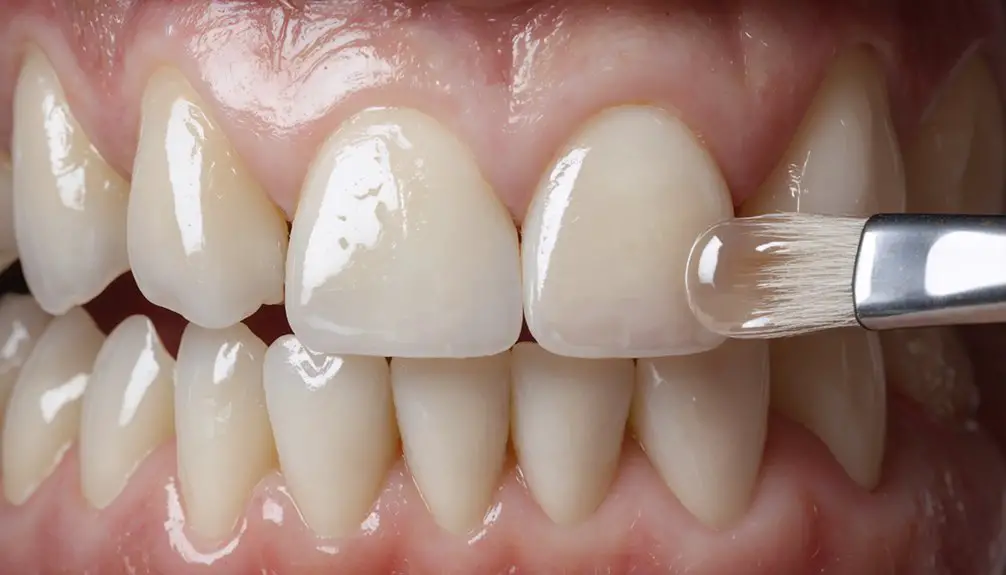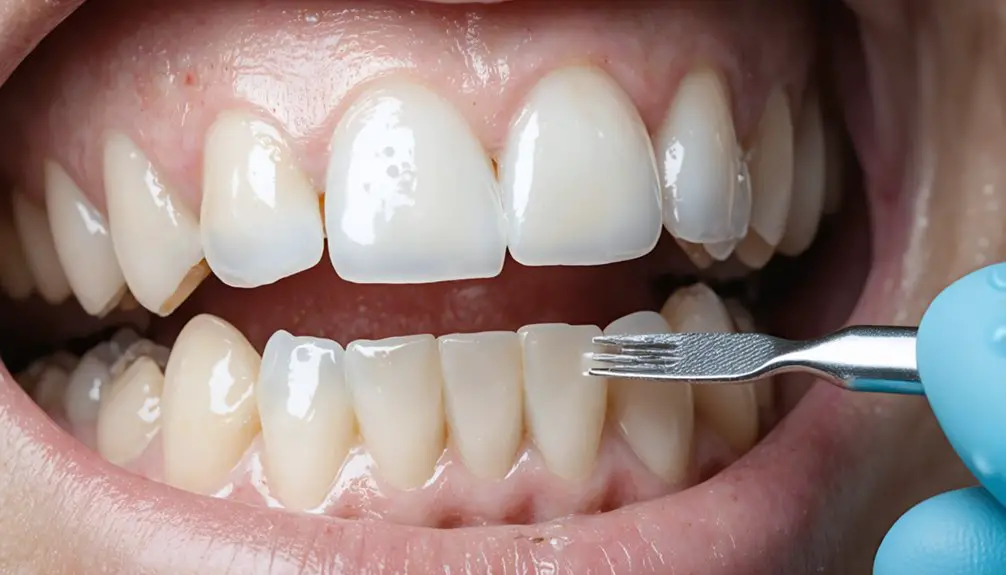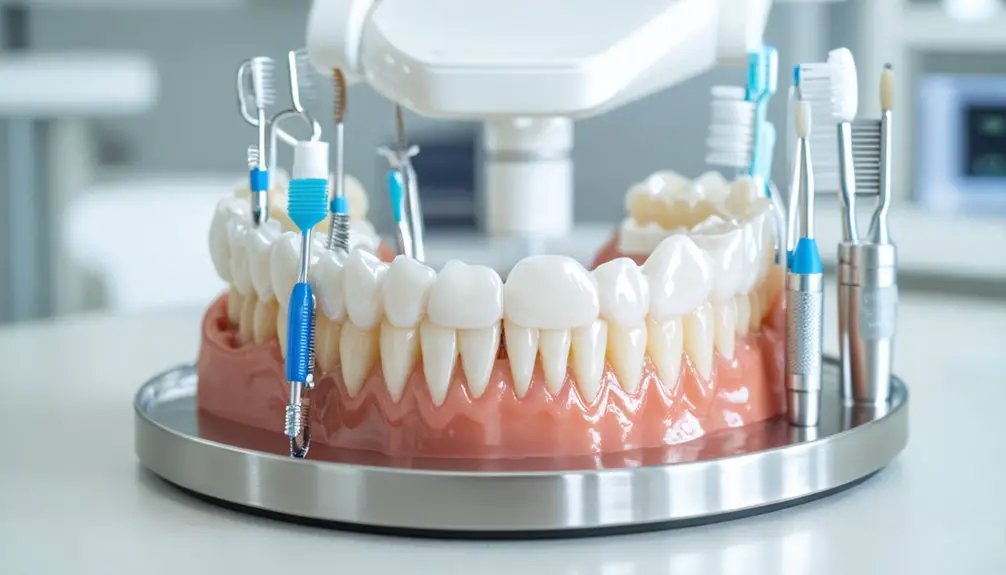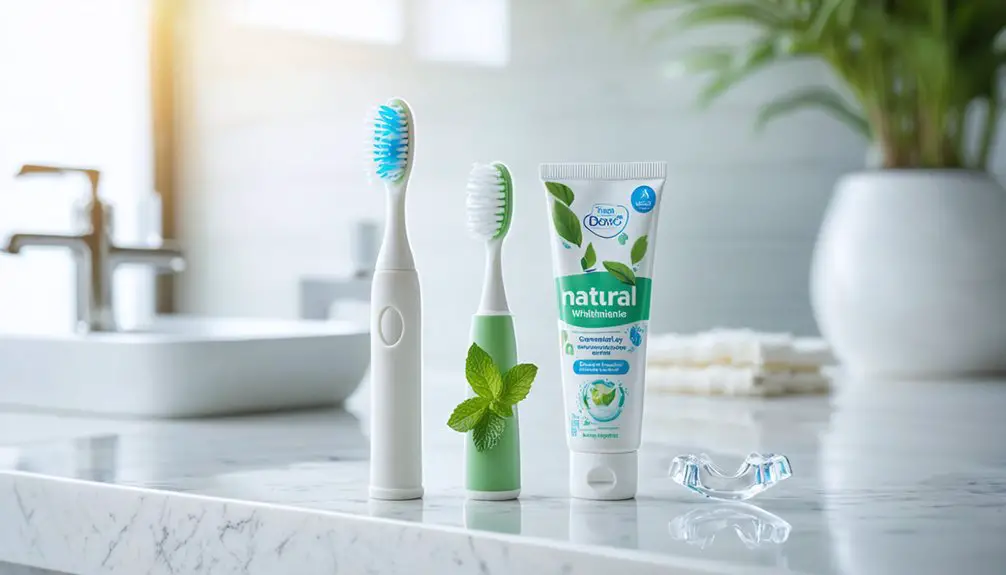Teeth whitening gels can cause temporary sensitivity in 24-50% of patients due to peroxide compounds penetrating your enamel and exposing nerve endings. You’ll typically experience sharp, transient discomfort during and after treatment, with higher peroxide concentrations (above 35%) increasing your risk. While most sensitivity resolves within two weeks as teeth remineralize, about 13-14% of patients stop treatment due to severe symptoms. Understanding proper management techniques can help minimize these effects.
Key Takeaways
- Whitening gels can temporarily demineralize tooth enamel, exposing nerve endings and causing increased sensitivity in 24-50% of patients.
- Higher peroxide concentrations above 35% significantly increase discomfort risk, affecting 60-90% of patients using these formulations.
- Chemical irritation from peroxide compounds penetrates enamel, reaching dental pulp and triggering sharp, transient pain during treatment.
- Most sensitivity symptoms resolve within two weeks, though 13-14% of patients may stop treatment due to severe discomfort.
- Mechanical pressure from whitening trays combined with gel exposure can amplify tooth sensitivity and gum irritation.
Understanding Teeth Sensitivity During Whitening Treatment
While teeth whitening treatments can effectively brighten your smile, they often cause temporary sensitivity during and after the procedure.
Understanding tooth anatomy helps explain why this occurs: whitening gels can slightly demineralize your enamel, making it more porous and exposing microscopic dentinal tubules that connect to nerve endings within your tooth.
When these tubules become exposed, you’ll likely experience heightened sensitivity to temperature changes and sweet foods. The bleaching agents can penetrate through your enamel and dentin, potentially reaching the tooth’s pulp where nerves reside. Using higher concentration agents typically increases sensitivity risks and discomfort.
The intensity of sensitivity varies based on factors like your enamel thickness and pre-existing dental conditions. If you have thin enamel or gum recession, you’re more susceptible to discomfort during treatment, as there’s less protective barrier between the whitening gel and your tooth’s nerve endings. Most sensitivity issues resolve naturally as teeth remineralize and seal over time.
The Impact of Peroxide Concentration on Tooth Discomfort
Because peroxide concentration directly influences tooth sensitivity during whitening treatments, understanding this relationship is vital for both practitioners and patients.
Dental professionals must grasp how peroxide levels affect patient comfort to deliver optimal whitening results with minimal sensitivity.
Higher concentrations, particularly those above 35%, consistently show increased risk of discomfort, with studies revealing sensitivity in 60-90% of patients experience discomfort after treatment.
Higher concentrations, particularly those above 35%, consistently show increased risk of discomfort, with studies revealing sensitivity in all participants using 35% hydrogen peroxide solutions.
When comparing peroxide effects, 37% carbamide peroxide demonstrates remarkably lower sensitivity risks than equivalent hydrogen peroxide concentrations. This chemical difference occurs because carbamide peroxide gradually releases hydrogen peroxide through a slower reaction process.
You’ll find that lower concentrations around 6% can achieve effective whitening while considerably reducing discomfort, especially when combined with LED activation.
A concentration comparison reveals that moderate levels between 10% and 40% offer varying sensitivity profiles, allowing practitioners to tailor treatments to individual needs.
For best results with minimal sensitivity, it’s essential to follow professional guidelines and manufacturer recommendations.
How Whitening Gels Trigger Sensitivity
Since whitening gels contain peroxide compounds that penetrate tooth structure, they can trigger sensitivity through multiple mechanisms. The peroxide effects include the release of free radicals that travel through your enamel and dentin, reaching the pulp where they cause inflammation and temporary nerve irritation. These effects commonly result in short shooting pains known as zingers.
Increased enamel permeability during whitening also allows more substances to reach the sensitive dentin layer beneath. Using desensitizing gel beforehand can help minimize these effects and prepare teeth for the whitening process.
Key factors that contribute to whitening-induced sensitivity include:
- Chemical irritation of dental pulp from peroxide penetration
- Temporary dehydration of enamel, making it more porous
- Mechanical pressure from whitening trays combined with heightened tooth sensitivity
You’ll typically experience these sensations during and shortly after treatment as your teeth respond to both the chemical exposure and structural changes.
Timeline and Severity of Sensitivity Symptoms
Most patients experience tooth sensitivity within minutes to hours after completing their whitening treatment.
Tooth sensitivity is an expected response to whitening treatments, typically beginning shortly after the procedure is complete.
You’ll typically notice sharp, transient discomfort triggered by temperature changes or pressure. The symptom duration usually lasts 24-72 hours, with peak intensity occurring immediately after treatment. Using custom-fitted trays helps minimize sensitivity by preventing gel from contacting sensitive gum tissue.
Sensitivity variations depend on several factors. Higher concentrations of whitening agents cause more intense but shorter-lasting symptoms, while lower concentrations may result in milder but prolonged discomfort.
If you have thin enamel, exposed dentin, or pre-existing dental conditions, you might experience symptoms lasting up to a week. This occurs because whitening agents temporarily open dentinal tubules that connect to the tooth’s nerve endings.
Professional in-office treatments generally cause shorter sensitivity periods compared to at-home kits. You’ll usually see marked improvement within 48-72 hours, though complete resolution may take up to a week.
Managing and Preventing Whitening-Related Sensitivity
While teeth whitening sensitivity is common, you can take proactive steps to minimize or prevent discomfort throughout your treatment process.
Effective sensitivity management begins with proper pre-whitening preparation, including the use of desensitizing toothpaste containing potassium nitrate several weeks before treatment. You’ll also want to strengthen your enamel through professional fluoride treatments and avoid acidic foods. Since most products contain hydrogen peroxide content, sensitivity to this ingredient is a primary concern.
During and after whitening, follow these essential practices:
- Choose whitening products with lower peroxide concentrations (5-6%) specifically designed for sensitive teeth.
- Maintain strict adherence to recommended application times to prevent overexposure.
- Use sensitivity-relief products containing nerve-calming agents and fluoride post-treatment.
Continue using desensitizing toothpaste and avoid extreme temperature foods for 24-48 hours after treatment to maintain peak comfort. If sensitivity persists beyond this timeframe, consult your dentist for personalized guidance on managing ongoing discomfort.
Scientific Evidence on Whitening Gel Safety
Scientific research provides compelling evidence about the safety profile of teeth whitening gels, with clinical studies extensively documenting both their effectiveness and potential risks.
While sensitivity affects 24-50% of patients, controlled trials confirm it’s typically temporary and reversible, with most discomfort resolving within two weeks of treatment.
Studies show that whitening effectiveness correlates with peroxide concentration, but higher levels increase sensitivity risks.
Patient experiences vary considerably, with 10-16% carbamide peroxide formulations offering a favorable balance between results and comfort.
Clinical data demonstrates no long-term pulp damage from short-term use, though 13-14% of patients may discontinue treatment due to severe sensitivity.
The addition of desensitizing agents in modern formulations helps minimize these effects while maintaining whitening efficacy.
Best Practices for Safe Teeth Whitening

To guarantee safe and effective teeth whitening results, following established best practices significantly reduces the risk of sensitivity and other adverse effects.
Following proven teeth whitening methods helps ensure both safety and effectiveness while minimizing unwanted side effects like tooth sensitivity.
You’ll achieve the best outcomes by choosing products with ADA approval and preferably using custom trays provided by dental professionals rather than over-the-counter options. These assure proper fit and minimize gel contact with your gums.
- Always follow manufacturer instructions rigorously regarding application time and frequency.
- Take immediate breaks if you experience tooth sensitivity or gum irritation.
- Schedule regular dental consultations to monitor your progress and address concerns.
Maintain your results by practicing good oral hygiene and avoiding stain-causing foods.
If you’re using home-based whitening treatments, custom trays offer superior results compared to generic alternatives, while professional supervision helps prevent potential complications from improper use.
Frequently Asked Questions
Can I Whiten My Teeth While Wearing Braces or Dental Restorations?
You shouldn’t whiten teeth during braces treatment or with dental restorations, as it’ll cause uneven results. Wait until braces removal, and consult your dentist about restoration safety before starting whitening procedures.
Do Natural Teeth Whitening Alternatives Cause Less Sensitivity Than Commercial Gels?
Want gentler teeth whitening? Natural remedies typically cause less sensitivity than commercial gels since they lack harsh peroxides, but they’re slower-acting and require longer use for noticeable results.
Does Regular Fluoride Use Affect the Effectiveness of Whitening Treatments?
You can safely continue fluoride treatments during whitening without compromising whitening effectiveness. In fact, fluoride helps protect your enamel while letting bleaching agents work effectively on surface stains.
How Does Age Influence Tooth Sensitivity During Whitening Procedures?
Your age factors considerably affect sensitivity levels during whitening. While younger patients often report higher sensitivity due to permeable dentin, older teeth may experience localized discomfort from exposed roots and worn enamel.
Can Medications or Medical Conditions Increase Sensitivity Risk During Teeth Whitening?
Yes, your medication impact and underlying condition effects can greatly increase sensitivity during whitening. You’ll need to tell your dentist about any medications or health issues before starting treatment.
References
- https://www.loudfamilydentistry.com/blog/teeth-whitening-related-statistics-on-effectiveness-and-sensitivity-incidence
- https://ec.europa.eu/health/scientific_committees/opinions_layman/en/tooth-whiteners/l-3/5-tooth-whitening-products.htm
- https://pmc.ncbi.nlm.nih.gov/articles/PMC4058574/
- https://fomm.amegroups.org/article/view/66778/html
- https://pmc.ncbi.nlm.nih.gov/articles/PMC10240089/
- https://harrisburgsmilesdental.com/why-does-teeth-whitening-cause-sensitivity-understanding-the-basics/
- https://tooth-doctor.com/severe-tooth-sensitivity-after-teeth-whitening/
- https://familydentistchandler.com/how-to-avoid-teeth-sensitivity-after-whitening/
- https://crest.com/en-us/oral-care-tips/teeth-sensitivity/teeth-whitening-sensitivity-causes-how-to-avoid-it
- https://www.scottgreenhalghdds.com/blog/10-tips-for-dealing-with-sensitivity-after-teeth-whitening



